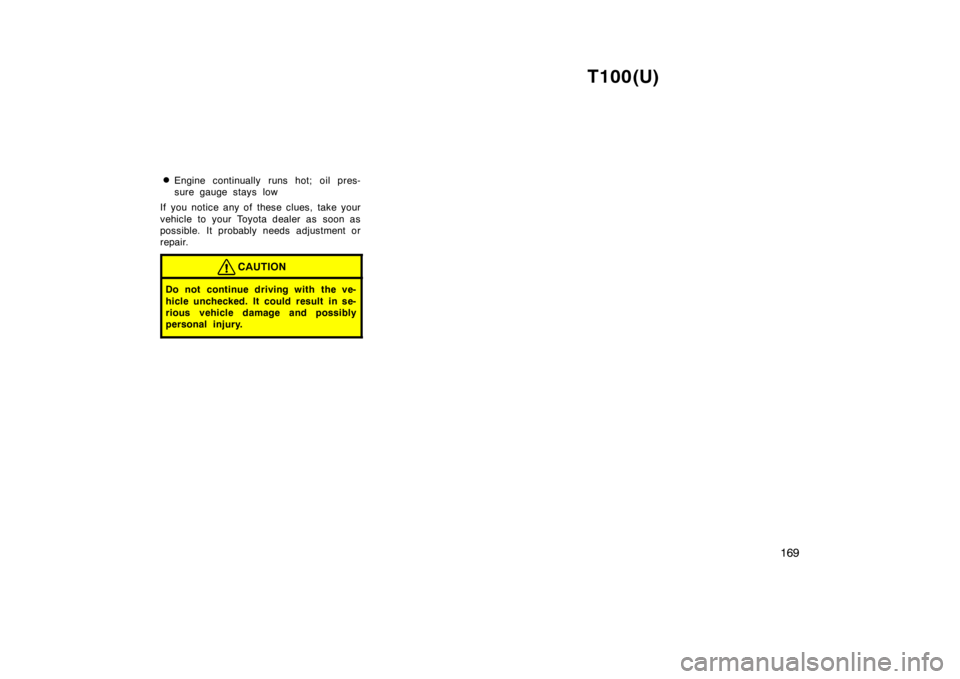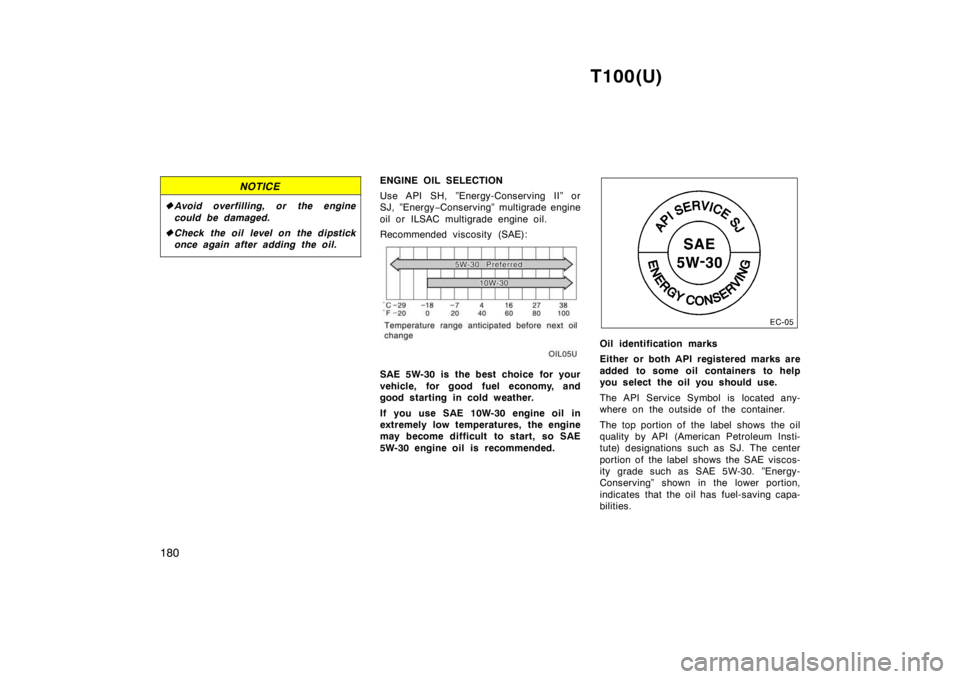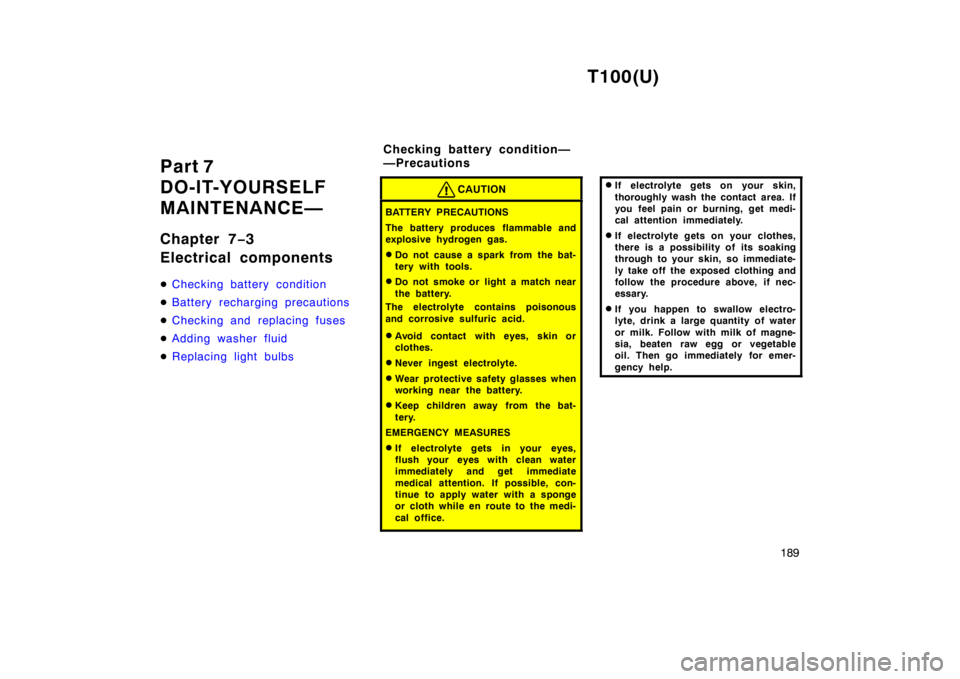1998 TOYOTA T100 check oil
[x] Cancel search: check oilPage 168 of 214

T100(U)
168
Engine coolant level
Make sure the coolant level is between
the ”FULL” and ”LOW” lines on the see-
through reservoir when the engine is cold.
See Chapter 7
−2 for additional information
when the engine is cold.
Battery electrolyte level
Make sure the electrolyte level of all bat-
tery cells is between upper and lower lev-
el lines on the case. Add only distilled
water when replenishing. See Chapter 7 −3
for additional information.
Brake fluid level
Make sure the brake fluid level is correct.
See Chapter 7 −2 for additional information.
Engine oil level
Check the level on the dipstick with the
engine turned off and the vehicle parked
on a level spot. See Chapter 7 −2 for addi-
tional information.
Power steering fluid level
Check the level on the dipstick. The level
should be in the ”HOT” or ”COLD” range
depending on the fluid temperature. See
Chapter 7 −2 for additional information. Exhaust system
If you notice any change in the sound of
the exhaust or smell exhaust fumes, have
the cause located and corrected immedi-
ately. (See engine exhaust cautions in
Part 2.)
Be on the alert for changes in perfor-
mance, sounds, and visual tip-offs that
indicate service is needed. Some impor-
tant clues are as follows:
� Engine missing, stumbling, or pinging
� Appreciable loss of power
� Strange engine noises
� A leak under the vehicle (however, wa-
ter dripping from the air conditioning
after use is normal.)
� Change in exhaust sound (This may
indicate a dangerous carbon monoxide
leak. Drive with the windows open and
have the exhaust system checked im-
mediately.)
� Flat-looking tire; excessive tire squeal
when cornering; uneven tire wear
� Vehicle pulls to one side when driving
straight on a level road
� Strange noises related to suspension
movement
� Loss of brake effectiveness; spongy
feeling brake or clutch pedal; pedal al-
most touches floor; vehicle pulls to one
side when braking
� Engine coolant temperature continually
higher than normal
Does your vehicle need
repairing?
Page 169 of 214

T100(U)169
�
Engine continually runs hot; oil pres-
sure gauge stays low
If you notice any of these clues, take your
vehicle to your Toyota dealer as soon as
possible. It probably needs adjustment or
repair.
CAUTION
Do not continue driving with the ve-
hicle unchecked. It could result in se-
rious vehicle damage and possibly
personal injury.
Page 176 of 214

T100(U)
176 �
Be careful not to scratch the glass
surface with the wiper frame.
� When closing the engine hood,
check to see that you have not for-
gotten any tools, rags, etc.
Parts and tools
Here is a list of parts and tools you will
need on performing do-it-yourself mainte-
nance. Remember all Toyota parts are de-
signed in metric sizes, so your tools must
be metric.
Checking the engine oil level
Parts (if level is low):
� Engine oil API grade SH, ”Energy-Con-
serving II” or SJ, “Energy −Conserving”
multigrade or ILSAC multigrade having
viscosity proper for your climate
Tools: � Rag or paper towel
� Funnel (only for adding oil)
Checking the engine coolant level
Parts (if level is low): � Ethylene-glycol antifreeze
� Demineralized or distilled water
Tools: � Funnel (only for adding coolant)
Checking brake fluid
Parts (if level is low): � SAE J1703 or FMVSS No.116 DOT 3
brake fluid Tools:
� Rag or paper towel
� Funnel (only for adding fluid)
Checking power steering fluid
Parts (if level is low): � Automatic transmission fluid DEXRON �
II or III
Tools: � Rag or paper towel
� Funnel (only for adding fluid)
Checking battery condition
Tools:
� Warm water
� Baking soda
� Grease
� Conventional wrench (for terminal
clamp bolts)
Checking and replacing fuses
Parts (if replacement is necessary): � Fuse with same amperage rating as
original
Page 179 of 214

T100(U)179
Part 7
DO-IT-YOURSELF
MAINTENANCE—
Chapter 7
−2
Engine and Chassis �
Checking the engine oil level
�Checking the engine coolant
level
�Checking brake fluid
�Checking power steering fluid
�Checking tire pressure
�Checking and replacing tires
�Rotating tires
�Installing snow tires and chains
�Replacing wheels
�Aluminum wheel precautions
Checking the engine oil level
With the engine at operating tempera-
ture and turned off, check the oil level
on the dipstick. 1. To get a true reading, the vehicle should be on a level spot. After turning
off the engine, wait a few minutes for
the oil to drain back into the bottom of
the engine.
2. Pull out the dipstick, and wipe it clean with a rag.
3. Reinsert the dipstick–push it in as far as it will go, or the reading will not be
correct.
4. Pull the dipstick out and look at the oil level on the end.
CAUTION
Be careful not to touch the hot ex-
haust manifold.
If the oil level is below or only slightly
above the low level, add engine oil of
the same type as already in the engine.
Remove the oil filler cap and add engine
oil in small quantities at a time, checking
the dipstick.
The approximate quantity of oil needed to
fill between the low level and the full level
on the dipstick is indicated below for ref-
erence.
When the level reaches within the correct
range, install the filler cap hand-tight.
Oil quantity, L (qt., lmp. qt.):3RZ −FE engine 1.5 (1.6, 1.3)
5VZ −FE engine
Two-wheel drive models 1.5 (1.6, 1.3)
Four-wheel drive models 1.4 (1.5, 1.2)
Page 180 of 214

T100(U)
180
NOTICE
� Avoid overfilling, or the engine
could be damaged.
� Check the oil level on the dipstick
once again after adding the oil.
ENGINE OIL SELECTION
Use API SH, ”Energy-Conserving II” or
SJ, ”Energy −Conserving” multigrade engine
oil or ILSAC multigrade engine oil.
Recommended viscosity (SAE):
SAE 5W-30 is the best choice for your
vehicle, for good fuel economy, and
good starting in cold weather.
If you use SAE 10W-30 engine oil in
extremely low temperatures, the engine
may become difficult to start, so SAE
5W-30 engine oil is recommended.
Oil identification marks
Either or both API registered marks are
added to some oil containers to help
you select the oil you should use.
The API Service Symbol is located any-
where on the outside of the container.
The top portion of the label shows the oil
quality by API (American Petroleum Insti-
tute) designations such as SJ. The center
portion of the label shows the SAE viscos-
ity grade such as SAE 5W-30. ”Energy-
Conserving” shown in the lower portion,
indicates that the oil has fuel-saving capa-
bilities.
Page 189 of 214

T100(U)189
Part 7
DO-IT-YOURSELF
MAINTENANCE—
Chapter 7
−3
Electrical components �
Checking battery condition
�Battery recharging precautions
�Checking and replacing fuses
�Adding washer fluid
�Replacing light bulbs
CAUTION
BATTERY PRECAUTIONS
The battery produces flammable and
explosive hydrogen gas. � Do not cause a spark from the bat-
tery with tools.
� Do not smoke or light a match near
the battery.
The electrolyte contains poisonous
and corrosive sulfuric acid. � Avoid contact with eyes, skin or
clothes.
� Never ingest electrolyte.
� Wear protective safety glasses when
working near the battery.
� Keep children away from the bat-
tery.
EMERGENCY MEASURES � If electrolyte gets in your eyes,
flush your eyes with clean water
immediately and get immediate
medical attention. If possible, con-
tinue to apply water with a sponge
or cloth while en route to the medi-
cal office.
�If electrolyte gets on your skin,
thoroughly wash the contact area. If
you feel pain or burning, get medi-
cal attention immediately.
� If electrolyte gets on your clothes,
there is a possibility of its soaking
through to your skin, so immediate-
ly take off the exposed clothing and
follow the procedure above, if nec-
essary.
� If you happen to swallow electro-
lyte, drink a large quantity of water
or milk. Follow with milk of magne-
sia, beaten raw egg or vegetable
oil. Then go immediately for emer-
gency help.
Checking battery c ondition—
—Precautions
Page 202 of 214

T100(U)
202
ENGINE LUBRICATION
Oil capacity (drain and ref
ill),
L (qt., Imp. qt.):
Two-wheel drive models 3RZ −FE engine
With filter 5.5 (5.8, 4.8)
Without filter 4.8 (5.1, 4.2)
5VZ −FE engine
With filter 5.2 (5.5, 4.6)
Without filter 4.9 (5.2, 4.3)
Four-wheel drive models With filter 4.7 (5.0, 4.1)
Without filter 4.4 (4.7, 3.9)
Oil grade: API grade SH, ”Energy-Conserving II”
or SJ, ”Energy-Conserving” multigrade
engine oil or ILSAC multigrade engine
oil is recommended.
Recommended oil viscosity (SAE):
COOLING SYSTEM
Total capacity, L (qt., Imp. qt.): Two-wheel drive models
With manual transmission 3RZ −FE engine
8.7 (9.2, 7.7)
5VZ −FE engine
10.0 (10.6, 8.8)
With automatic transmission
3RZ −FE engine
9.0 ( 9.5, 7.9)
5VZ −FE engine
9.9 (10.5, 8.7)
Four-wheel drive models With manual transmission
10.0 (10.6, 8.8)
With automatic transmission 9.9 (10.5, 8.7)
Coolant type: With ethylene-glycol antifreeze
(Do not use alcohol type.)
BATTERY
Open voltage �
at 20 �C (68 �F):
12.6—12.8 V Fully charged
12.2—12.4 V Half charged
11.8—12.0 V Discharged
� : Voltage that is checked 20 minutes after
the key is removed with all the lights
turned off
Charging rates: 5 A max. CLUTCH
Pedal freeplay, mm (in.):
5—15 (0.2—0.6)
Fluid type:
SAE J1703 or FMVSS No.116 DOT 3
MANUAL TRANSMISSION
Oil capacity, L (qt., Imp. qt.): 3RZ −FE engine
2.6 (2.7, 2.3)
5VZ −FE engine
Two-wheel drive models
2.6 (2.7, 2.3)
Four-wheel drive models 2.2 (2.3, 1.9)